Car Audio Wire Gauge Guide With Charts
When upgrading your car stereo system, it’s important to get the right sized wire gauge, and while there are many factors at play this wire gauge guide will give you enough knowledge to understand which size to get.
Whether it’s for your amplifier, subwoofer, speakers or other components, getting the right size of wire is critical to getting the best out of your new equipment.
Getting it wrong will not only affect the sound of your music, but it could damage your audio equipment, your car’s electrical wiring, and worst case scenario you could even trigger a fire in your car.
In this article we look at the main types of car audio wiring and the different size wire gauge you need for each one. There’s a wire gauge chart for each explanation, which should give you a close enough idea of the gauge you need.
American Wire Gauge (AWG)
Most of the world uses the American Wire Gauge (AWG), which is the US standard measure for the diameter of electrical conductors. It’s based on the number of dies originally needed to draw the copper down to the required size. So, the lower the number, the thicker the wire gauge.
AWG was first introduced in 1857 as a standard to replace the various measurements used by different manufacturers. The biggest wire gauge size is 0000 AWG, whereas the smallest standard size is 40 AWG.
This is used for both solid wires and stranded wires, although stranded copper wires can be slightly bulkier than solid wires, even though they’re the same gauge. Even so, using the AWG wire gauge guide will lead you to the same result.
There’s much debate about whether a higher strand count improves your audio performance, but really it’s not about the more strands of wire, it’s about getting the right wire gauge.
Make Sure You Secure The Wire Connections Properly
Using a wire gauge guide is necessary for getting the right size, but connecting the wires securely is also critical when installing any audio equipment as it will ensure you get a good, solid connection.
A bad connection can quickly come loose, and if it does it can cause many problems for your stereo system and a headache you don’t need.
There are many different types of connectors, and some are better for certain electrical wiring, but whichever connector you use, make sure you have a solid connection.
Crimp Connectors are good enough. Basically, they’re an electrical connector used for terminating or connecting stranded wires. The wire will go into the connector and as long as you crimp it with some crimpers, you will get a permanent, solid grip.
Soldering is also another great way to secure your electrical wiring. It’s a bit more work, but as long as it’s done right, with the correct soldering equipment, it is the most secure way of connecting your wires and audio equipment.
Soldering wires will give you the best connection, but make sure you do the job right. If you’ve never done it before, I’d recommend getting some crimp connectors, because badly soldered connections can lead to many problems.
Once you’ve connected your wires, it’s always a s good idea to shrink wrap the connections. This will protect them from dust and dirt and strengthen your connection, ensuring your wires will never pull apart.
So, now you have all the information on the AWG standard and getting the best connection for your electrical wiring, it’s time to look at the wire gauge guide for each installation.
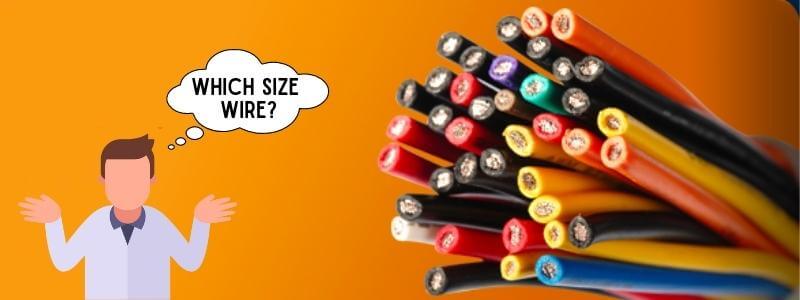
Grounding Connections
Grounding connections are needed for all electrical devices installed into a car. A ground is a negative electrical connection that powers up the unit, and it will mostly be connected to the chassis of the car. A bad grounding is probably the most common cause for car audio problems, so make sure you get this right.
Ground wires should mount securely to clean, unpainted metal or dedicated ground points on the chassis. A great place to connect the grounding is under the seatbelt bolt, as it will give you a secure connection to your chassis.
The Ground wires should be the right size wire gauge needed for the application. So, if you’re installing a 600W amplifier, your grounding wire gauge needs to be able to power that.
Generally, your grounding wire will be the same size as the power cable which I discuss just below, so for the right wire gauge guide for your grounding follow the power cable size.
Wiring an Amplifier In Your Car
Your amplifier is one of, if not the most energy sapping pieces of audio equipment, and the bigger the RMS your amp can push, the bigger the power cable you will need.
If you run too small a power wire your amplifier could quickly get damaged, so make sure you get this right.
To work out the wire gauge needed for your power cable you need an idea of how much current your amp will try to consume, and on how long the wiring run from battery to amplifier will be.
To work out the approximate amperes of your amplifier, you need to multiply the number of channels by the RMS per channel. If you have more than one amp, you need to add them all together, and divide that by the efficiency and then the voltage.
There are two common types of amplifiers: D Class and A/B Class. You never get 100% efficiency out your amp, so it throws another spanner in the works. Generally, Class D amps are more efficient and you should get around 75% efficiency, whereas with an A/B amp you will get around 50% efficiency.
So, to work it out: If you have a Class D amplifier, you need the total RMS divided by 0.75 Amp Efficiency divided by 13.8 Volts to get your Current Draw in Amperes.
So, if you have a 600W RMS Class D amp, your math will be 600/0.75/13.8 = 57.9710145, which rounded up is 58 amperes.
As you can see in the wire gauge chart below, the gauge needed for an 8 foot power cable would be 8 gauge.
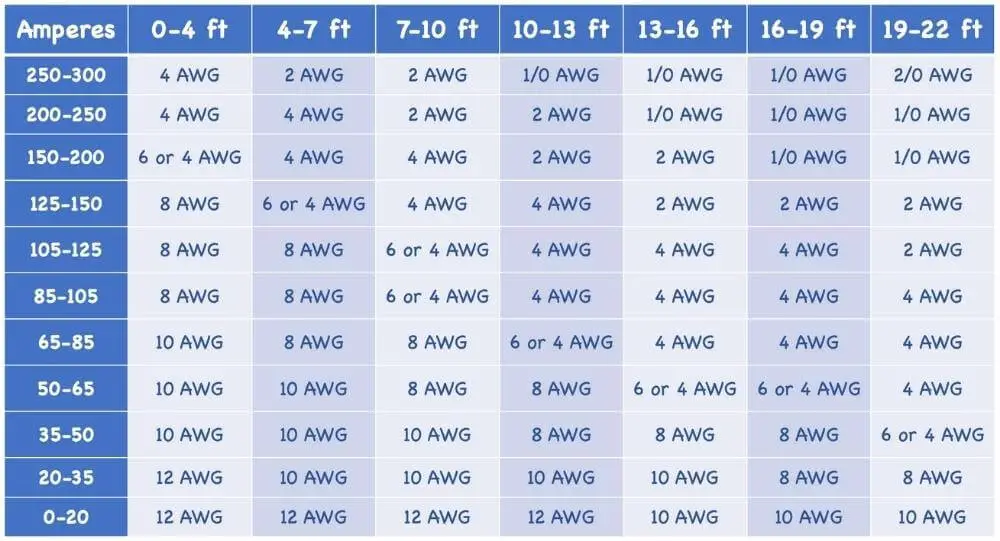
If you have an A/B Class, you need the total RMS divided by 0.50 Amp Efficiency divided by 13.8 Volts to get your Current Draw in Amperes.
So, if you have a 600W amp, your math will be: 600/0.5/13.8 = 86.956521, which I’d round up to 87 amperes.
As you can see in the wire gauge guide above, the AWG I’d need for a power cable of the same length would be either 6- or 4 gauge wire. I would always round down and go for the bigger wire so I’d get a 4 gauge power cable. Quite a difference from the D Class amp above!
Other Wires Running From Amplifier to Receiver
You can get amp wiring kits with all the wires and connectors in, which are a good idea as you can keep hold of them in case you need to replace any wires further down the line.
All amplifiers will come with a Remote Turn-on Wire, but if you have to replace it, you should get an 18 AWG blue wire.
For the RCA Jacks, you will just need to replace them with some standard RCA male-to-male jacks. These usually come between 22 gauge to 18 gauge, and the more powerful your amplifier is, the better it is to go with the bigger 18 gauge
Speaker Wires
Running speaker wires, whether it’s directly from your head unit or from your amplifier, allows your speakers to receive the audio signal, so they can reproduce those amazing sounds we all love to drive along to.
Speaker wires are typically 2 separate stranded wires molded together, with one strand being the positive + and the other strand being the negative – strand.
There are many different qualities of speaker wire, so it’s a necessity that you get the best you can afford, because cheaping out on speaker wires, will cause you problems and you won’t get the best out of your audio equipment.
Some cheaper wires that claim to be a certain gauge might not be, and instead you’ll be buying more plastic sleeve than wire.
Depending on the speakers you have will determine the wire gauge you need, and below in the wire gauge chart you can work out what is best for you.
Factory speakers will run on pretty much any size wire, as the power demands are minimal. But of course, most people into audio upgrade their car speakers, so getting the right size wire is necessary for you speakers and subwoofers.
Aftermarket speakers need more power, so the electrical wiring that drives the signal to them needs to be bigger than factory speakers.
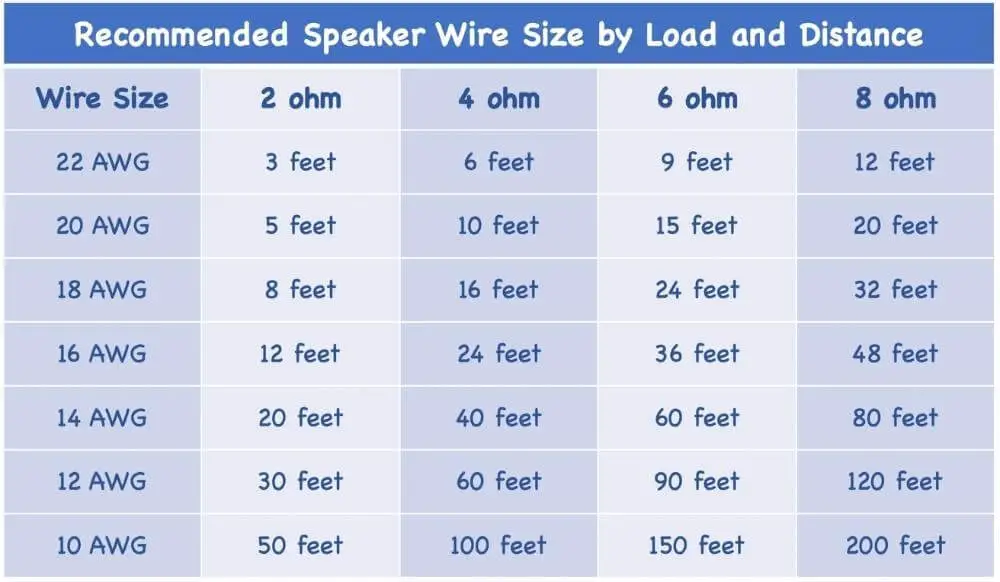
Speaker wires are usually between 18-14 gauge, but to work out the size for yours, you should know the Impedance and distance.
Looking at the chart above: If you are running speakers at 4 ohms and the distance needed is 20 feet, then you are between 18 and 16 AWG. In this case I would always go for the bigger wire, so go for 16 gauge.
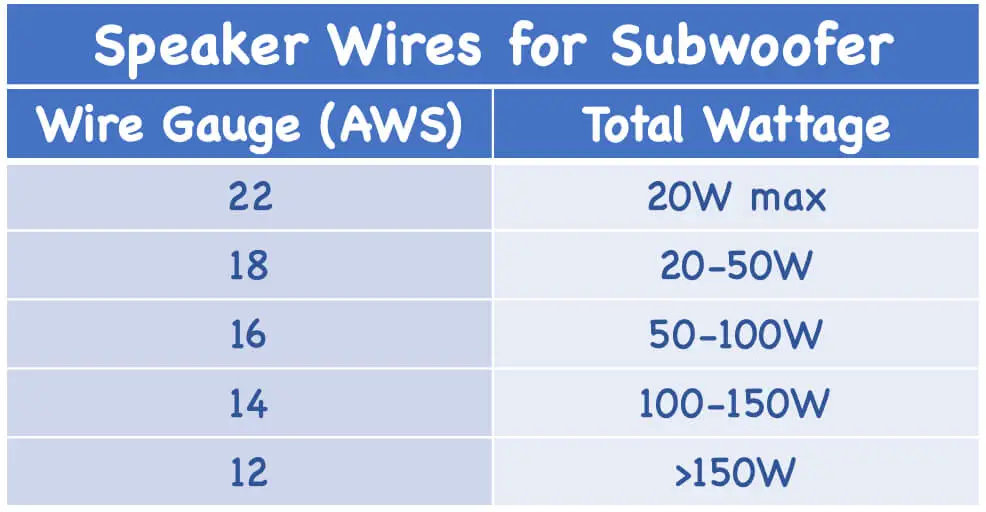
For subwoofers the speaker wire will tend to be a bit bigger. Usually you will need as big as 14-12 AWG, but the calculations are the same as the speaker wires on the wire gauge chart above.
Although another general rule of thumb is to work out its total wattage, and looking at the wire gauge chart here with RMS wattage, you can just go for that size wire.
You can use both wire gauge guides to come up with the wire size you need, but generally speaking you should need something between 16- and 12 gauge speaker wire for your subwoofer. And always go for the bigger wire if you’re getting mixed results.
Crossover Wiring
Using a crossover gives you more control over your sound system, but many people get confused with the electrical wiring.
Crossovers need 12v of power, which many people think it needs a thicker gauge wire, but because crossover demands less current, as a general guide 18 gauge wire is usually fine.
Wire Conversion Chart
All measurements in the wire gauge charts above are imperial, but for anyone who works in metric (most of the world), please find the wire gauge chart below for converting inches to millimeters useful.
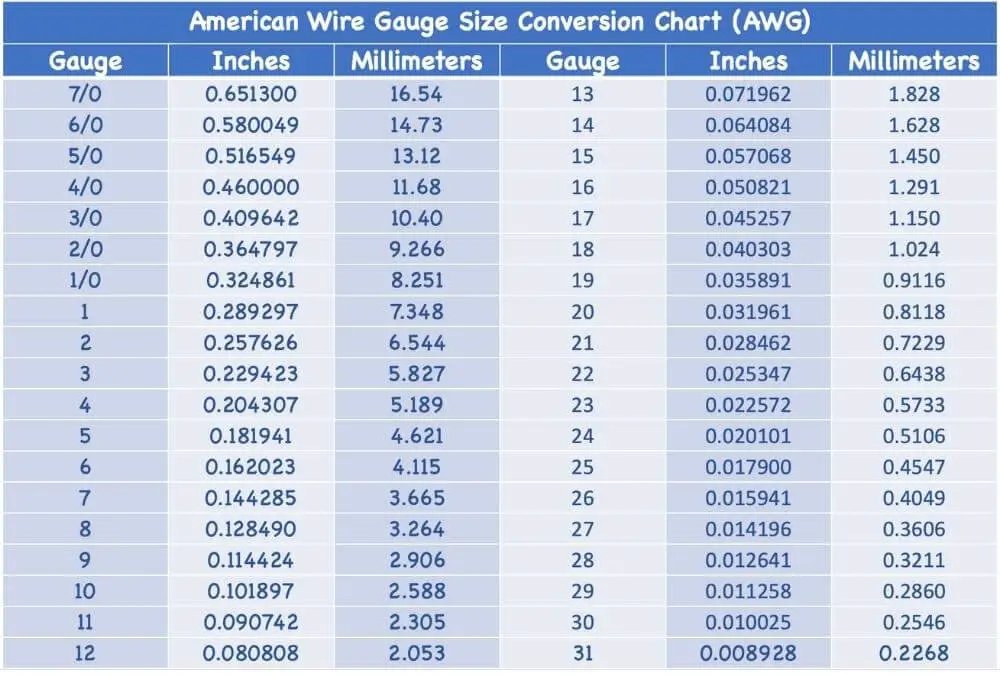
Choosing The Right Size Wire for The Right Audio Equipment
So there you have it, a wire gauge guide for all the important electrical wiring in your car stereo system.
All the different wire sizes can be confusing, but looking at the charts or even a wire gauge calculator will give you a better understanding of which size to get.
All wiring is important, but pay particular attention to your power leads and do the math correctly for the total amperage and distance, because this is where you could get most problems.
Always ensure you buy good quality wiring, because you don’t want more sleeve than wire. There are some great amp wiring kits out there with all wires needed, so if you need the full bundle one of these is a good way to go.
Last but not least, always make sure you connect all wires with a good solid connection. Whether it’s crimp connectors or soldered connections, it’s up to you, but whichever way, make sure you test the connection with a few good tugs as you wire everything up.
If you have any questions and need more wire gauge guidance, leave a message in the chatbox below and we will get back to you.
FAQs About Electrical Wiring Gauge
Why do you need different gauge for different wire lengths?
Basically, resistance increases the longer electrical current has to travel. This is because as it’s travelling the electrical resistance builds up, so the longer it is, the more resistance. And the electrical current can only travel so far before there’s a voltage drop, which is why you need a bigger power cable.
What happens if I go too small with wire size?
If you get too small a size wire, it depends, but it’s not good. You might be lucky and just temporarily lessen the quality of of your soundstage, or you could damage your equipment and even set your car on fire.
The problem is determined by the wrong wires you install. That’s why it’s always necessary to know the correct size you need by looking at wire gauge guides.
What happens if If I go too big?
If you go too big, don’t worry too much as it won’t damage anything. But of course if you go too big it will cost you unnecessary outlay as the bigger wires are more expensive.
Also, the bigger the wire, the more room it will take up and the harder it is to bend. So, try and get it right, but too big is definitely better than too small.
What happens if my wires are too long?
When you buy the wires, it’s always a good idea to buy more than enough. However, when you install your audio equipment, don’t leave too much wire hanging out or even rolled behind something, even if it’s hidden.
Cut the wire at the appropriate length, because longer wires add unnecessary resistance and can create impedance. It also leaves your car looking messy.

I am a passionate and skilled car audio enthusiast with 15 years of experience in the industry. My journey started when I replaced my first set of factory car speakers, sparking a deep love for high-quality sound. Since then, I have worked as a representative for renowned brands like Kenwood and Alpine.
With a background in both retail and distribution, I have developed a comprehensive understanding of the car audio market. Currently a certified (MECP) installer in the Mobile Electronics industry, my expertise lies in delivering top-notch audio installations. My knowledge, coupled with my genuine passion, makes me the go-to professional for all car audio needs.


Thank you Andrew. Great information, wish you were near my place so I can have a professional like you look at my ride.
No worries. Happy to help from afar!